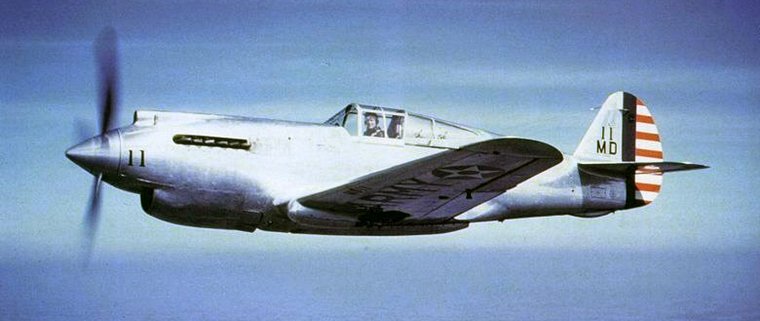
















Curtiss P-40 Warhawk-Tomahawk-Kittyhawk
By Willie Bodenstein
The liquid-cooled single stage supercharged Allison V-1710 V-12 Curtis XP-40, a modernisation of the radial powered Curtiss P-36, first flew on 14 October 1938. Curtiss opted to go this route to reduce development time and enabled a rapid entry into production and operational service. The USAAC (U.S. Army Air Corp) was impressed with the sleek in line fighter and placed an order for 524, the largest single engine fighter order ever placed.

Warhawk was the name the USAAC adopted for all models whilst British Commonwealth and Soviet air forces used the name Tomahawk for models equivalent to the P-40B and P-40C whilst P-40D and later variants were called Kittyhawks.


The P-40 was not a bad aircraft. Its lack of a two stage supercharger though was a serious drawback in high altitude encounters with Germanys Bf 109s and Fw 190s in North Africa. Nevertheless, competent pilots who took advantage of the P-40's strengths were effective against the best of the Luftwaffe and Regia Aeronautica (Italian Air Force). It was rarely to see service in North West Europe but played a major role North Africa, China, Italy, Eastern Europe and the Middle East.

The P-40s were considered superior to the Hurricane that in 1942 was the primary fighter of the Desert Air Force. The gradual replacement of Hurricanes by the Tomahawks and Kittyhawks led to the Luftwaffe accelerating retirement of the Bf 109E and introducing the newer Bf 109F. Tomahawks and Kittyhawks from then on bore the brunt of Luftwaffe and Regia Aeronautica fighter attacks during the North African campaign until eventually replaced by tropicalized Spitfires.
At least 46 British Commonwealth pilots achieved ace status flying the P-40. Royal Air Force and Commonwealth forces claimed 285 enemy aircraft shot down for 100 losses during the North African Campaign. The highest scoring South African was Jack Frost who scored 15 victories, seven in the P-40.

On the opposite side of the world a group of volunteers would immortalise the P-40. The 1st American Volunteer Group more commonly known as the Flying Tigers was a unit of the Chinese Air Force staffed by volunteers recruited from the U.S. Their leader Claire Chennault trained his pilots to use the P-40's particular performance advantages and they were highly successful. According to their official records, in just 6 1/2 months, the Flying Tigers destroyed 115 enemy aircraft for the loss of just four of their own in air-to-air combat.

United Sates Air Force (USAAF) Warhawks saw extensive service in the Mediterranean Theatre of Operations (MTO.) While the P-40 suffered heavy losses success in combat depended in part on experience and effective tactics. Many USAAF P-40 units achieved high kill-to-loss ratios against Axis aircraft. In all 23 U.S. pilots became aces in the MTO while flying the P-40.


Contributing to the longevity of the P-40 whose production run continued throughout the war was its relatively low unit cost, US$44,892 in 1944, semi modular design that made it easy to maintain in the field, strong structure including a five spar wing and ability to literally soak up punishment.

The P-40 might not be one of the most successful fighters during WWII but none the less almost 14,000 were built between 1939 and 1944. It was the third most-produced American fighter, after the P-51 and P-47. Of the almost 14,000 built approximately 35 are currently airworthy whilst another 36 airframes are under restoration for either display or flight.

General characteristics
Crew: 1
Length: 31.67 ft (9.66 m)
Wingspan: 37.33 ft (11.38 m)
Height: 12.33 ft (3.76 m)
Wing area: 235.94 ft² (21.92 m²)
Empty weight: 6,070 lb (2,753 kg)
Loaded weight: 8,280 lb (3,760 kg)
Max. take-off weight: 8,810 lb (4,000 kg)
Powerplant: 1 × Allison V-1710-39 liquid-cooled V12 engine, 1,150 hp (858 kW)
Performance
Maximum speed: 360 mph (310 kn, 580 km/h)
Cruise speed: 270 mph (235 kn, 435 km/h)
Range: 650 mi (560 nmi, 1,100 km)
Service ceiling: 29,000 ft (8,800 m)
Rate of climb: 2,100 ft/min (11 m/s)
Wing loading: 35.1 lb/ft² (171.5 kg/m²)
Power/mass: 0.14 hp/lb (228 W/kg)
Armament
Guns: 6 × .50 in (12.7 mm) M2 Browning machine guns with 235 rounds per gun in the wings
Bombs: 250 to 1,000 lb (110 to 450 kg) bombs to a total of 2,000 lb (907 kg) on three hard points (one under the fuselage and two under wing)
 |
 |
 Copyright © 2024 Pilot's Post PTY Ltd
The information, views and opinions by the authors contributing to Pilot’s Post are not necessarily those of the editor or other writers at Pilot’s Post.
Copyright © 2024 Pilot's Post PTY Ltd
The information, views and opinions by the authors contributing to Pilot’s Post are not necessarily those of the editor or other writers at Pilot’s Post.